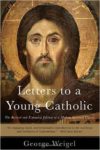Last year I attended Mass on Christmas Day, rather than Eve. I simply hadn’t had the time in the midst of co-hosting the biggest family gathering of the year. But this Christmas Eve, we were done setting up early. Mom’s 3:00 ready-time had miraculously happened, which meant I could attend 4:00 Mass before the extended family arrived.
Christmas is a time of celebration, a literal Christ Mass to welcome the Messiah’s birth. I envisioned the early-evening Mass akin to the celebrations of old, where the family attended church and then had a feast. And a feast we had—a four-course meal awaited us, complete with the traditional seven fishes. We would welcome Jesus into the world, and then celebrate Italian style.
We arrived at church twenty minutes early.
It wasn’t enough.
The nave was packed, standing room only. Parishioners spilled into the narthex. I was crammed into a back corner, jostled every time the door behind me opened. Kids stepped on my feet as they restlessly bounced from one parent to the other. I didn’t have a hymnal, so I only knew the first couple verses of the Christmas hymns. I was accompanied by shushing parents and the crinkling of their children’s bags of snacks.
As I later learned, 4:00 Mass isn’t for celebrating Christ before the feast. 4:00 is to get it over with and get the kids to bed. 4:00 is convenient for those who only attend Mass on Christmas and Easter. The Creasters.
This was not the celebration I had envisioned.
The pinnacle of celebration, the Eucharist, was upon us. I felt a wash of relief, but for the wrong reasons: the rapid emptying of the church. People received the Host in their winter jackets, then filed right out the door. Before the Eucharistic table was even cleared, a third of the congregants had left. Some of us standees hesitated, like the occupants of those empty pews might actually return. But before long, we were moving in.
My lower back was starting to twinge, so I was grateful for the seat and cushioned kneeler. But it also made me sad. Partially for myself, because I’d spent most of Christmas Eve Mass trying (and failing) to push away my annoyance. But mostly for the Creasters. For the ones who left, and for those who’d attended because “that’s just what we do.” I was sad for the restless kids who don’t understand why they have to go to this weird, fancy building when they should be home waiting for Santa. Because Jesus isn’t part of their lives; He’s a twice-a-year obligation. He’s just a baby in a manger, then the resurrected God. He has no life, no ministry, and no death.
“From now on,” I said in the car afterward, “I’m sticking to Christmas day Mass.”
I’m certainly complaining a lot, but it didn’t ruin my Christmas. We had the celebratory feast, and kept the constant reminder of Who we celebrated. And, as I’m inclined to remind everyone, Christmas isn’t over yet. It’s not a single-day celebration—it’s a season, and I refuse to take down my tree until it’s properly over. Everyone has switched over to “Happy New Year,” but I still wish my fellow Catholics a Merry Christmas. Jesus has arrived!
My hope is that some of those Creasters in our packed churches remembered the importance of the celebration. I hope they’ve made resolutions to be active in church again, and keep them. I hope they remember that Jesus is more than just Christmas and Easter, and so are we. Maybe they won’t, be I’ll try not to be cynical. After all, God has wrought bigger miracles.

